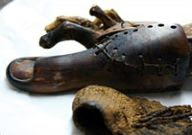
We could have alien origins, say scientists who sent fossilized microscopic life-forms into space and back inside an artificial meteorite. The researchers attached the baseball-size rock to the outside of the European Space Agency's Foton M3 spacecraft to test whether biological material could survive the round-trip journey. Sculpted from stone from the Orkney Islands in northern Scotland, the rock contained fossilized microbes and the molecular signatures of microbes. The unmanned spacecraft was launched by rocket from Kazakhstan's Baikonur Cosmodrome carrying 43 experiments. The craft landed in Kazakhstan on September 26 after orbiting the planet for 12 days. "In the bit of rock we got back, some biological compounds have survived," said project leader John Parnell from the University of Aberdeen in Scotland. Preliminary findings suggest that it's possible simple organisms could arrive via meteorites, he said.
The research also suggests that living microbes would likely have survived in a slightly bigger rock, he added. "This study of organic material is completely new," he said. Previous artificial meteorite experiments have examined only the degree to which rocks melt upon entering the atmosphere.
View: Full Article | Source: National Geographic



































